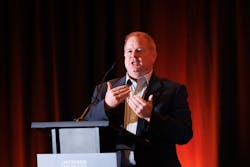A California tribal microgrid has won state funding to install one of the largest zinc-based battery projects in the world, marking another step in what's become an ongoing push to accelerate long-duration storage on the state and federal level.
The 20-MWh system will be part of a large-scale solar and storage microgrid for the Paskenta Band of Nomlaki Indians.
Funding for the battery system is being provided by the California Energy Commission (CEC) through its long duration energy storage grant program. The program focuses on developing commercially viable non-lithium energy storage technologies to address grid stability and resilience.
Funds from the program are often awarded to projects that benefit underserved groups, such as tribal communities.
Sustainable energy independence
The Paskenta Rancheria microgrid will enable the tribe to control its own energy resources, giving it greater energy sovereignty and a resilient and sustainable way to power its operations.
Like many other tribal communities, the Paskenta are working to reduce fossil fuel consumption and be good stewards of the land.
Jonah Steinbuck, director of the Energy Research and Development Division at the California Energy Commission said the Paskenta project “reflects the CEC’s goal to commercialize proven long duration energy storage solutions and support the energy sovereignty of tribal nations.”
One of the largest long duration storage projects in the world
The microgrid is being developed by California-based Faraday Microgrids (previously Charge Bliss) and Mazzetti provided the electrical design.
Brisbane, Australia’s Redflow will provide 2,000 zinc-bromine (ZBM3) flow batteries in its 200-kWh modular energy pods. The ZBM3 technology can provide up to 12 hours of energy capacity.
The battery system will be charged by the microgrid’s solar array and is designed to reduce Paskenta Rancheria’s grid demand while also boosting its energy security.
“The resiliency, operational performance, and safety of Redflow’s zinc-bromine flow battery technology will support the sustainability, reliability, and energy self-sufficiency goals of both the State of California and the Paskenta Band of Nomlaki Indians,” said David Bliss, CEO of Faraday Microgrids.
This installation will be the largest single deployment of Redflow’s battery technology to date.
The company said it has delivered 3-GWh in total, including a 2-MWh system that was installed at a California anaerobic digester in 2022.
Long duration storage market is growing quickly
Tim Harris, CEO and managing director at Redflow said that the market for long duration energy storage (LDES) is accelerating and California leads the development and support of non-lithium technologies to achieve its net-zero goals.
The state estimates it will need 45-55 GW of long duration energy storage by 2045 if it hopes to hit its climate targets.
LDES technology was a popular topic at Microgrid 2023: Lights On!, the annual industry conference hosted by Microgrid Knowledge last month in Anaheim, California.
During a keynote panel session Mark Feasel, chief commercial officer of FuelCell Energy, said that long duration energy storage is a nascent technology, but it is commercially viable. “It's going to take some time to get some of the kinks out of it, but it is an amazing technology,” he said.
Discussion about LDES is heightening as the electric industry begins to consider resource adequacy in shorter and shorter time intervals, according to Feasel.
“That was maybe a boring old, sleepy topic 30 years ago when consumers just kind of took what you gave them. It's gotten a lot more exciting these days. As consumers embrace distributed energy and microgrids, they may choose to use or not use energy at different times of day than you're expecting.”
Because it can store energy for long periods for future dispatch, long duration storage may offer an alternative to generators to guarantee the grid has the resources it needs during these shorter intervals.
Another speaker, Katrina Pielli, director of the Office of Engagement at the US Department of Energy, shared findings of the DOE’s recently announced “Liftoff Report” on long duration energy storage.
“To meet the 2050 carbon reduction goals, the net zero, we need 225 to 460 gigawatts of long duration energy storage and that means you need $330 billion in cumulative capital,” Pielli said.
She acknowledged that these are huge numbers to “just be that one slice of meeting the 2050 goal,” but the investment is critical.
According to the Liftoff Report, net-zero pathways that deploy long duration energy storage by 2050 will deliver annualized savings of $10-20 billion in operating costs and avoided capital expenditures compared to those without LDES.
She said the DOE worked with the private sector in developing the report, which shows how to get from inception to the commercialization of this new technology in a way that achieves maximum buy-in.
“The hope is by putting this out and having done hundreds of conversations with everyone from investors to developers to technology companies, that we really all try to settle on [a] common fact base to help drive investment, but also help drive development and deployment along the way as well,” Pielli added.
Track news on microgrids and long duration energy storage. Subscribe to the free Microgrid Knowledge Newsletter.









